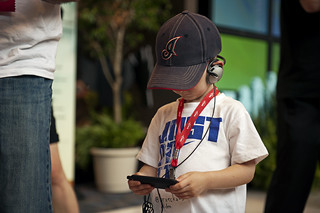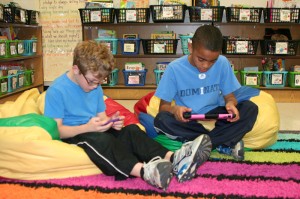
ISTE 2012 is underway. On Tuesday at 12:15 PM PST I’ll be moderating a panel discussion around 1:1 computing in education. A top notch panel has been assembled to contribute to the session. They’re all leading 1:1 initiatives in their districts and bring a wealth of experience to the table. But we need your help, your voice. We need to know what questions you have about going 1:1. However, the questions have to go beyond the device. We need to consider all aspects that contribute to building a successful 1:1 or BYOD program.
How can you contribute? Take a few minutes to look over our backchan.nl document. Vote for the topics and questions you feel are most relevant to this discussion. Feel free to add any questions you feel are missing. Make your voice heard and help shape the conversation that unfolds Tuesday. We appreciate your time and input.
From the ISTE porgram:
Transcending the Device: Crucial Conversations around 1:1
Jeremy Brueck, University Of Akron with Benjamin Grey, Jim Klein, Scott Meech, Matt Montagne and Joe Morelock
iPad2, Xoom, Playbook, iPod Touch, netbook, iPhone, Chromebook, this list of potential 1:1 devices continues to grow on a seemingly daily basis. Nearly everyday, a new device is hyped, over-hyped and pushed into our consciousness by a barrage of media and market glam. Due to the pervasiveness of mobile technologies into daily life, countless questions from school leaders and teachers continue to arise around mobile computing devices, specifically which device is best for creating a 1:1 program in a school or district.
Traditionally, much of the 1:1 discussion centers on “what” device to purchase, rather than what the school intends to accomplish with 1:1. Through a variety of perspectives provided by the distinguished panel members, we will discuss both the overarching goals of 1:1 implementations, as well as debate the merits of iOS, Android, Linux, netbooks, iPads, laptops and other devices commonly associated with 1:1. This discussion will provide the information ISTE attendees need to begin this journey in their own school or district, including useful advice, best practices and practical strategies, from a panel of highly qualified experts who have an established track record of success in the 1:1 arena.
Creating 1:1 spaces enables students to learn in an environment where students can own their learning and are engaged meaningful work. Establishing a new environment for this type of learning takes careful planning and consideration. There is some research that indicates 1:1 computing can produce impressive results. Findings indicate that 1:1 computing can provide greater access to resources, information, and up-to-date instructional content. In addition, 1:1 environments can lead to increased student motivation, engagement, interest, organization, and self-directed learning. Join a collection of educational thought leaders from across the country for an interactive conversation focused on developing, deploying and sustaining a successful 1:1 program.
Photo Credit: Enjoying the Keynote by Ben Grey on Flickr
none








